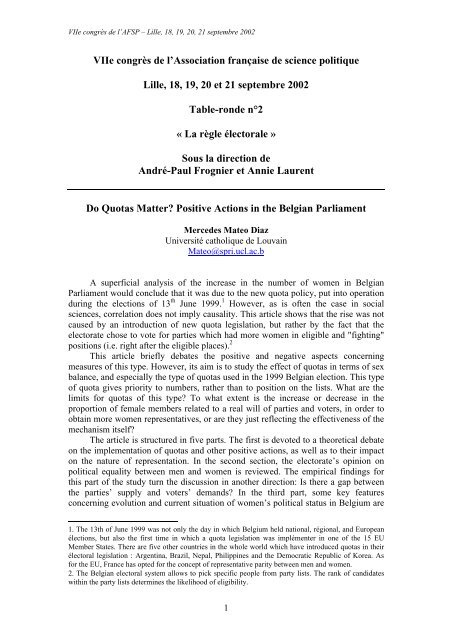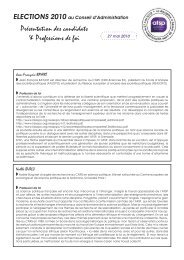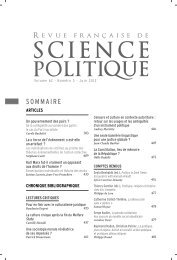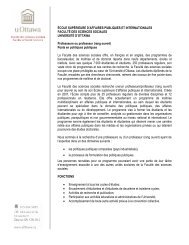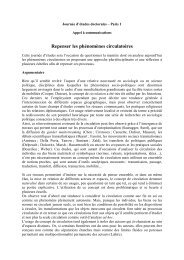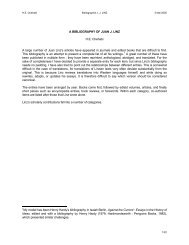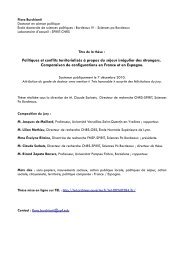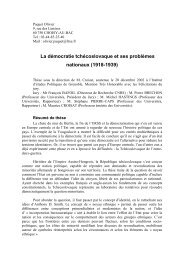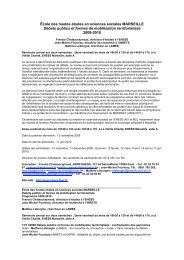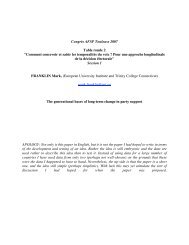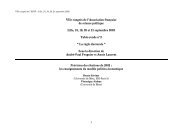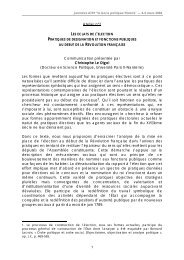VIIe congrès de l'Association française de science politique Lille, 18 ...
VIIe congrès de l'Association française de science politique Lille, 18 ...
VIIe congrès de l'Association française de science politique Lille, 18 ...
You also want an ePaper? Increase the reach of your titles
YUMPU automatically turns print PDFs into web optimized ePapers that Google loves.
<strong>VIIe</strong> <strong>congrès</strong> <strong>de</strong> l’AFSP – <strong>Lille</strong>, <strong>18</strong>, 19, 20, 21 septembre 2002<br />
<strong>VIIe</strong> <strong>congrès</strong> <strong>de</strong> l’Association <strong>française</strong> <strong>de</strong> <strong>science</strong> <strong>politique</strong><br />
<strong>Lille</strong>, <strong>18</strong>, 19, 20 et 21 septembre 2002<br />
Table-ron<strong>de</strong> n°2<br />
« La règle électorale »<br />
Sous la direction <strong>de</strong><br />
André-Paul Frognier et Annie Laurent<br />
Do Quotas Matter? Positive Actions in the Belgian Parliament<br />
Merce<strong>de</strong>s Mateo Diaz<br />
Université catholique <strong>de</strong> Louvain<br />
Mateo@spri.ucl.ac.b<br />
A superficial analysis of the increase in the number of women in Belgian<br />
Parliament would conclu<strong>de</strong> that it was due to the new quota policy, put into operation<br />
during the elections of 13 th June 1999. 1 However, as is often the case in social<br />
<strong>science</strong>s, correlation does not imply causality. This article shows that the rise was not<br />
caused by an introduction of new quota legislation, but rather by the fact that the<br />
electorate chose to vote for parties which had more women in eligible and "fighting"<br />
positions (i.e. right after the eligible places). 2<br />
This article briefly <strong>de</strong>bates the positive and negative aspects concerning<br />
measures of this type. However, its aim is to study the effect of quotas in terms of sex<br />
balance, and especially the type of quotas used in the 1999 Belgian election. This type<br />
of quota gives priority to numbers, rather than to position on the lists. What are the<br />
limits for quotas of this type? To what extent is the increase or <strong>de</strong>crease in the<br />
proportion of female members related to a real will of parties and voters, in or<strong>de</strong>r to<br />
obtain more women representatives, or are they just reflecting the effectiveness of the<br />
mechanism itself?<br />
The article is structured in five parts. The first is <strong>de</strong>voted to a theoretical <strong>de</strong>bate<br />
on the implementation of quotas and other positive actions, as well as to their impact<br />
on the nature of representation. In the second section, the electorate’s opinion on<br />
political equality between men and women is reviewed. The empirical findings for<br />
this part of the study turn the discussion in another direction: Is there a gap between<br />
the parties’ supply and voters’ <strong>de</strong>mands? In the third part, some key features<br />
concerning evolution and current situation of women’s political status in Belgium are<br />
1. The 13th of June 1999 was not only the day in which Belgium held national, régional, and European<br />
élections, but also the first time in which a quota legislation was implémenter in one of the 15 EU<br />
Member States. There are five other countries in the whole world which have introduced quotas in their<br />
électoral legislation : Argentina, Brazil, Nepal, Philippines and the Democratic Republic of Korea. As<br />
for the EU, France has opted for the concept of representative parity between men and women.<br />
2. The Belgian electoral system allows to pick specific people from party lists. The rank of candidates<br />
within the party lists <strong>de</strong>termines the likelihood of eligibility.<br />
1
addressed. Thereafter, in the fourth section, positive actions un<strong>de</strong>rtaken by Belgian<br />
political parties are <strong>de</strong>scribed. Finally, the fifth and last section shows the effects of<br />
the Smet-Tobback law (legislation on quotas) on sex distribution in the Belgian<br />
Fe<strong>de</strong>ral Chamber of Representatives. 1<br />
The Theoretical Base to Use Quotas<br />
One of the recurrent topics in literature of the last <strong>de</strong>ca<strong>de</strong>s is the issue of certain<br />
groups’ over-representation and other groups’ un<strong>de</strong>r-representation. Bernard Manin<br />
has referred to this as «the aristocratic character of representation». 2 In the French<br />
Manifest for parity printed one year after the publication of Manin’s book, «the<br />
aristocratic character of representation» is <strong>de</strong>scribed as follows: «Representative and<br />
executive functions are monopolised by a leading group, small in number, extremely<br />
homogeneous by its training, and with an early insertion in the main bodies of the<br />
State. Stable by its composition and lowly permeable in its access, such a leading<br />
group constitutes a '<strong>de</strong>mocratic aristocracy' un<strong>de</strong>r cover of a republican elite.» 3 This<br />
unbalanced situation has also been called 'Parliament’s social bias'.<br />
Why is it important for different groups to be represented in accordance with<br />
their number in society as a whole? Answers to this question seem to fall into two<br />
broad categories. The first claims that it is a matter of rights, i.e. that <strong>de</strong>mocracy is<br />
about equality (i.e. "one woman/one vote", and "every citizen has the same right to be<br />
elected"), and thus, the right to an equal social representation is a basic right. The<br />
second is based on more utilitarian arguments, i.e. in or<strong>de</strong>r to benefit from women’s<br />
competence, this half of humanity should be part of the political system. Moreover,<br />
the entry of new actors (e.g. women) in the political arena will change and improve<br />
politics, bringing a "political renewal". This would not only mean the entry of new<br />
issues and priorities onto the political agenda, but would also bring politics and<br />
politicians closer to the people.<br />
Pippa Norris and Joni Lovenduski use a supply and <strong>de</strong>mand mo<strong>de</strong>l to explain<br />
why Parliaments remain ‘unrepresentative’ according to several criteria such as<br />
occupation, education, sex, race and age by distinguishing between two different<br />
types of factors: those that prevent the entry of certain individuals to the recruitment<br />
process, and those that stop <strong>de</strong>cision-makers from choosing a particular type of<br />
individual. Two types of attitu<strong>de</strong>s are a handicap for certain candidates, and thus help<br />
to reproduce 'social bias'. Firstly, a direct discrimination, <strong>de</strong>fined as «positive or<br />
negative judgement of individuals on the basis of supposed characteristics of the<br />
group to which they belong, rather than on the basis of their own individual<br />
characteristics.» And secondly, an imputed discrimination which can be <strong>de</strong>scribed as<br />
«the anticipated reaction amongst the electorate towards certain social groups.» 4<br />
1. The Chamber of Representatives has been selected for the analysis because it is the stronger fe<strong>de</strong>ral<br />
legislative assembly. The Belgian Fe<strong>de</strong>ral Parliament is ma<strong>de</strong> up of two Chambers, namely the<br />
Chamber of Representatives and the Senate. It is however an asymmetric system, where the distribution<br />
of competences strongly favours the Chamber of Representatives. The focus on this Chamber allows an<br />
analysis at the national level, together with comparisons within and between Francophone and Flemish<br />
parties.<br />
2. MANIN, B., 1995.<br />
3. See 'Le Manifeste <strong>de</strong>s dix pour la parité', L'Express du 06 juin 1996.<br />
4. "Party members may personally favour a certain category of candidate […], or a particular applicant<br />
[…]. But members may be unwilling to choose such a candidate because they expect they would lose<br />
votes among the electorate." See NORRIS, P. & LOVENDUSKI, J., 1995:107.<br />
2
A system based on social representation requires assemblies to reflect social<br />
composition. David Held refers to this as «statistical representation», or the method of<br />
election in which representatives are a sample of the group as a whole, chosen among<br />
«those who are statistically representative of key social categories including gen<strong>de</strong>r<br />
and race». 1 However, arguments that view social proportionality as an indicator of the<br />
<strong>de</strong>gree of fairness within a political system are controversial. If a system is consi<strong>de</strong>red<br />
unfair because, women remain a minority in Parliament even though they are 50<br />
percent of the population, the same could be argued about other physically distinct<br />
groups such as ethnicity or age. The line of discussion has moved from the question of<br />
"why is it necessary to have representative assemblies and political equality" onto the<br />
more specific matter of "why should gen<strong>de</strong>red political equality be introduced?" One<br />
of the main arguments of this latter <strong>de</strong>bate has been that since all societies have<br />
always been gen<strong>de</strong>red, and thus have become an essential component of them all, it is<br />
different from the rest.<br />
A number of temporary and <strong>de</strong>finitive actions have been <strong>de</strong>signed and applied<br />
by parties and Parliaments with the intention of achieving a sex-balanced legislative<br />
assembly. However, it is also essential to point out the conceptual differences between<br />
Belgian «quotas» and French «parity» when discussing this subject. From a distance,<br />
these two concepts could be seen as something similar, i.e. a temporary measure of<br />
correction, in or<strong>de</strong>r to reach a political balance between men and women. But this is<br />
not so. French «parity» is claimed to be a <strong>de</strong>finitive measure that goes beyond<br />
quantitative aspects.<br />
More than just being simple actions, necessary to reach political equality<br />
between men and women, each of the two concepts - quotas and parity - represent a<br />
particular vision of society. While the first views it as organized in groups with well<strong>de</strong>fined<br />
interests, the i<strong>de</strong>a behind the second is that politics has to mirror mankind's<br />
duality. The concept of démocratie paritaire, stipulates that political power should be<br />
shared on a "fifty-fifty" basis between men and women. Approved and inserted into<br />
French constitution, its critics stressed that the conceptual frame of mixité disguised a<br />
"50-50" quota. However, the fact of gen<strong>de</strong>r being consi<strong>de</strong>red as an essential<br />
component of all societies, prevents other social groups from pleading for a similar<br />
law, unlike that which would happen in the quota system. Even if the conceptual and<br />
philosophical basis of the two concepts are thus claimed to be different, it is not<br />
possible to distinguish between the two approaches when it comes to their practical<br />
implementation.<br />
Despite provoking numerous <strong>de</strong>bates in Belgium, the principle of quotas was<br />
seen as a ‘natural’ way with which to achieve a sex-balanced representation. This was<br />
due to the country’s tradition in allowing different groups to share power. Therefore,<br />
as Eliane Gubin and Leen Van Molle (1998) argue, when the «<strong>de</strong>mocratie paritaire»<br />
became a political priority of the 1990s, measures aiming to achieve a political<br />
balance between the sexes could not be postponed. It seemed natural to guarantee men<br />
and women equal representation, in the same way as it had traditionally been done<br />
with different language-groups.<br />
An Electorate with Positive Views on Gen<strong>de</strong>r Equality<br />
Albeit the article’s main aim to present the effect of quota law in the Belgian<br />
Fe<strong>de</strong>ral Chamber of Representatives and to illustrate variations in representativity, it<br />
is clear that quotas are only one of the factors, amongst others, which can influence<br />
1. HELD, D., 1997:325.<br />
3
the candidate and representative selection process. In a political system strongly<br />
dominated by the role of political parties, the mechanisms of recruitment within each<br />
of them are not to be neglected. 1 Sometimes, <strong>de</strong>mocratic processes e.g. elections<br />
within the parties, are not necessarily successful in giving new, un<strong>de</strong>r-represented<br />
actors a higher presence on the lists. To the contrary, the oligarchic system, i.e.<br />
<strong>de</strong>cision-making ma<strong>de</strong> from the party’s elite or top-down processes, could be more<br />
effective. Another important component is the strength and impact of women’s<br />
branches within the different political parties, as they have often encouraged gen<strong>de</strong>r<br />
equality reforms.<br />
However, even in a system dominated by parties, the electorate has had its say,<br />
especially in relation to preference votes. In the last instance, voters and not parties<br />
<strong>de</strong>ci<strong>de</strong> by which candidate they want to be represented. Thus, to have a gen<strong>de</strong>rbalanced<br />
Parliament is not enough to force parties to present sex-balanced lists, since<br />
voters also have to vote for both men and women.<br />
Different campaigns have promoted the vote for women throughout the<br />
electorate. In 1988, before the local elections, Miet Smet set off the campaign Vote for<br />
a balanced local council («Votez pour l'équilibre dans votre conseil communal»). 2 In<br />
1994, a new campaign was organized for local and provincial elections un<strong>de</strong>r the<br />
slogan What about changing the face of Belgian politics ("Et si on changeait le visage<br />
<strong>de</strong> la <strong>politique</strong> Belge"). For the 1995 elections, the campaign Vote for a balance<br />
between men and women ("Votez pour un équilibre entre les femmes et les hommes")<br />
was launched with the support of the authorities, women’s party’s and non-party’s<br />
organizations. The Belgian Electoral Study 3 that was carried out in 1995 sustains that<br />
more men (38 percent) than women (28 percent) had heard about the campaign. Thus,<br />
only a third (around 33 percent) of all the interviewees were aware of it. The level of<br />
awareness was higher in Flan<strong>de</strong>rs (38 percent) than in Wallonia (28 percent).<br />
To know about a campaign and to be influenced by it, are two different things.<br />
Of those voters who had heard about the campaign, 16 percent admitted that their vote<br />
was influenced by it. According to the interviewee’s responses women (25 percent)<br />
were influenced twice as much as men (10 percent). The impact also seems to have<br />
been somewhat higher in the Flemish part of the country. These results suggest that<br />
the real impact of that type of initiative, although limited, should not be neglected.<br />
How many more people voted for women in 1999 compared to 1995? Or, in<br />
other words, did people really want to see more women taking part of politics<br />
disregarding the political party for which they voted? Between 1995 and 1999, the<br />
number of voters who chose 'men only' in Wallonia <strong>de</strong>creased by almost fifty percent<br />
(from 38 to 20). While the percentage that voted only for women essentially did not<br />
change (around 7 percent), the percentage that voted for both men and women<br />
increased by 20 percent (from 54 to 74). A similar, but weaker, ten<strong>de</strong>ncy is found<br />
amongst Flemish voters. In 1995, 49 percent of the electors voted exclusively for<br />
men, a vote that was repeated in 1999 by 35 percent of the electorate (a <strong>de</strong>crease by<br />
14 points). At this latter date, 12 percent voted only for women (an increase of 2<br />
points with respect to the former date). The percentage of voters who chose both men<br />
and women increased by about 10 points (from 42 to 53 percent). The exclusive vote<br />
for men remains stronger in Flan<strong>de</strong>rs than in Wallonia.<br />
1. For an analysis of the recruitment process see NORRIS, P. & LOVENDUSKI, J., 1995.<br />
2. Miet Smet is a member of the CVP (Christian-<strong>de</strong>mocratic party) and was Ministry of Labour and<br />
Equal Opportunities during the legislative period 1995-1999.<br />
3. Source data: ISPO-PIOP, 1995 and 1999 General Election Study Belgium, Leuven/Louvain-la-<br />
Neuve. Supported by the Fe<strong>de</strong>ral Services for Technical, Cultural and Scientific Affairs (SSTC).<br />
4
Attitu<strong>de</strong>s towards the female role in politics have also changed, becoming more<br />
positive, especially among the male voters. Both surveys 1 inclu<strong>de</strong>d a series of 5 point<br />
scales going from «completely agree» to «completely disagree» measuring attitu<strong>de</strong>s<br />
towards women’s roles in politics. The following concepts were presented: 'female<br />
politicians are more efficient in <strong>de</strong>aling with female interests', 'politics should be left<br />
to men', 'I have more confi<strong>de</strong>nce in male politicians', 'politics would improve if there<br />
were more female politicians', 'half of the elected politicians should be women',<br />
'women are as suitable in politics as men', and 'more women in politics, more<br />
<strong>de</strong>mocracy', the latter was only inclu<strong>de</strong>d in 1999.<br />
According to a majority of the electorate, female politicians are better equipped<br />
to represent female interests - as opposed to male politicians. It ought to be noted that<br />
the percentage who thought so in 1999 was lower (62 percent) than in 1995 (65<br />
percent). However, there has been an increase (from 67 and 53 percent in 1995 to 82<br />
and 65 percent in 1999) in the numbers of those who disagree with the following<br />
statements ‘politics should be left to men’ ‘I have more confi<strong>de</strong>nce in male<br />
politicians’. Both female (42 percent in 1999) and male (44 percent in 1999) Flemish<br />
respon<strong>de</strong>nts are hesitant on the statement that ‘politics would improve if there were<br />
more female politicians'. In Wallonia, there is a similar level of hesitance (40 percent<br />
in 1999) among male respon<strong>de</strong>nts, but a relative majority of the female ones (41<br />
percent) agree with the former statement that ‘politics would improve if there were<br />
more female politicians'. More than 80 percent of the Belgian electorate believes that<br />
women are equally as suited as men for politics, and a relative majority (48 percent)<br />
also maintains that half of the representatives ought to be women. Finally, in contrast<br />
to a relative majority (49 percent in 1999) of Wallonian respon<strong>de</strong>nts ‘more women in<br />
politics, more <strong>de</strong>mocracy’, Flemish respon<strong>de</strong>nts are more sceptical about the<br />
statement. In 1999, 33 percent of them agreed, and 43 percent answered 'neither agree<br />
nor disagree'. The main conclusion to be extracted from the attitu<strong>de</strong>s expressed is that<br />
most respon<strong>de</strong>nts want more women in politics. They do not want politics to be left<br />
exclusively to men, and consi<strong>de</strong>r women to be just as suitable for politics as men,<br />
thinking that half of the representatives should be women. Why do they have this<br />
opinion? Since the electorate does not seem to believe that women would improve<br />
politics and <strong>de</strong>mocracy these attitu<strong>de</strong>s do not seem to be <strong>de</strong>termined by utilitarian<br />
arguments. Can it be conclu<strong>de</strong>d that their attitu<strong>de</strong>s are influenced by their beliefs<br />
about rights for certain groups?<br />
Consi<strong>de</strong>ring the electorate’s positive attitu<strong>de</strong>s towards female politicians, the<br />
number of women in the Belgian Parliament remains strangely low, only 23 percent.<br />
What is preventing more women from being elected to Parliament?<br />
Some Key Features of the Belgian Women’s Political Status<br />
In Belgium, women's right to vote and to be elected were achieved<br />
progressively. 2 In 1921, women obtained the right to be candidates in local, provincial<br />
and legislative elections. The same year the first woman was co-opted to be a member<br />
of the Senate. In 1948 the right to vote was accor<strong>de</strong>d to all women. 3 They voted for<br />
the first time in 1949, twenty-eight years after men. In May 1994, almost fifty years<br />
later, the Belgian government <strong>de</strong>ci<strong>de</strong>d to introduce quotas in the composition of the<br />
electoral lists as a legal action in favour of women’s political rights.<br />
2. In this case, data also come from the Belgian 1995 and 1999 Electoral Studies.<br />
2. See MATEO DIAZ, M. & AISH, A.-M-, 1999.<br />
3. See UNION INTERPARLEMENTAIRE, 1995:78.<br />
5
Apart from the electoral system reforms, other specific bodies have been set up<br />
in or<strong>de</strong>r to fight against disparities between men and women. Since 1985, Belgium<br />
has a Secrétariat d’Etat à l’Emancipation sociale,with its own administration and<br />
budget. For this secretariat, «women's participation in the <strong>de</strong>cision-making process<br />
constitutes one of the main axes of women's emancipation policy. The other two main<br />
axes are women's integration into socio-economic life, and the elimination of violence<br />
against women and children.» Since January 1987, there is an Advice committee for<br />
social emancipation in the Chamber of Representatives, whose mission is to give<br />
recommendations, from its own initiative or following a request from the Chamber. 1<br />
The Comité d'avis pour l'égalité <strong>de</strong>s chances entre les hommes et les femmes,<br />
belonging to the Senate, was foun<strong>de</strong>d on January <strong>18</strong> th 1996 as a result of a proposal<br />
ma<strong>de</strong> by all female senators, after the U.N.'s 1995 Beijing conference on women's<br />
rights.<br />
By looking at the evolution of the number of female MPs in Belgium (figure 1),<br />
we can observe that in general the percentage of women increased in each election<br />
between 1946 and 1999. The exceptions are the 1965, 1971 and 1981 elections. In<br />
these elections, the parties which lost mandates were those which used to have more<br />
women representatives.<br />
Figure 1. Evolution of the number of women MPs in Belgium between<br />
1946-1999 2<br />
Today's proportion of women MPs is more than three times that of the mid<br />
1970s. Gubin and Van Molle (1998) stress that the 1974 Belgian election turned out to<br />
be a significant change in women’s political careers. In this election, political parties<br />
<strong>de</strong>ci<strong>de</strong>d to increase the number of women on their lists, as a reaction to pressure from<br />
the Parti Féministe Unifié and the campaign "Votez femme". 3 Nevertheless, there was<br />
not a strong increase in the number of women within the Belgian Parliament until the<br />
1999 election. Women MPs constituted 6.6 percent in 1974, 12 percent in 1995, and<br />
23 percent in 1999.<br />
The approval of the legislation on parity in France has reopened and rekindled<br />
the discussion in Belgium. Un<strong>de</strong>r the label «double parity», Belgium is now on its<br />
way to adopting a progressive and provisory formula with which to reach sex<br />
equilibrium in the political arena. In addition, a committee for political renewal,<br />
constituted by members of both assemblies, the Senate and the Chamber, has been<br />
1. See UNION INTERPARLEMENTAIRE, 1992, p. 50.<br />
2. Data come from: UNION INTERPARLEMENTAIRE, 1995, completed with IPU website figures<br />
consulted on the 15/01/2001.<br />
3. See CELIS, K., FLOUR, E., GODFROID, A., JACQUES, C. & PIETTE, V., 1998:35.<br />
6
created. 1 Its main objective is to <strong>de</strong>liberate concerning rules which may improve<br />
Belgian <strong>de</strong>mocracy in issues like institutions' functionning (i.e. Senate and Chamber),<br />
party's lists composition by sex, enlargement of electoral constituencies, or the use of<br />
a referendum… It is interesting to note that women are seen and therefore expected to<br />
be a factor of change in Belgium’s <strong>de</strong>mocracy. 2 Gen<strong>de</strong>r equality has become a<br />
potential source of political renewal. 3<br />
Before analysing the effects of the "Smet-Tobback" law in the 1999 election, the<br />
way in which quotas have been applied in each political party ought to be examined.<br />
Quotas in political parties 4<br />
What is the position of the diverse Belgian political parties towards quotas?<br />
Verzele and Joly classify them into four main ten<strong>de</strong>ncies: "parties <strong>de</strong>fending an<br />
extension of precise measures in or<strong>de</strong>r to reach parity (i.e. Green parties, Christian<strong>de</strong>mocratic<br />
parties and VU-ID); parties refusing quotas and proposing the suppression<br />
or neutralization of the 'top of the list' <strong>de</strong>volution effect (effet dévolutif <strong>de</strong> la case <strong>de</strong><br />
tête) 5 as a solution to the problem of female un<strong>de</strong>r-representation (i.e. Liberal parties);<br />
parties in favour of parity, without proposing specific measures (i.e. Socialist parties);<br />
a party wishing to abolish any i<strong>de</strong>a about quotas, without any proposals on the matter<br />
(i.e. Vlaams Blok)". 6<br />
Before the adoption of the general law imposing quotas in the composition of<br />
lists, some political parties had themselves implemented quotas . In the 1995<br />
elections, the Francophone Christian-<strong>de</strong>mocratic party (PSC) 7 applied a 2/3 maximum<br />
quota for each sex. Since 1992, the Flemish Socialist party (SP) has reserved a quarter<br />
of their seats to women on their electoral lists. Rather early, Flemish Christian<strong>de</strong>mocratic<br />
women (CVP) were strongly committed to increasing the presence of<br />
women in politics. Instead of using formally binding quotas, since 1974 the CVP has<br />
promoted several measures in or<strong>de</strong>r to increase the number of women, such as<br />
recommendations concerning the positions, and to reserve a minimum of 20 percent to<br />
female candidates on list. Other parties have not implemented quotas as such. In 1993,<br />
the Flemish Green party (Agalev) ratified parity. However, not a single woman from<br />
this party obtained a seat in the Parliament (0/4) in the 1995 election. In 1992, the<br />
Flemish Liberal party (VLD) abolished statutory regulations imposing a minimum of<br />
1. See Intervention of Mr. Luc Pâque, PSC. In Han<strong>de</strong>lingen van <strong>de</strong> Plenaire Verga<strong>de</strong>ringen, De Kamer,<br />
21.12.1999.<br />
2. Belgian Senate, 28th of March 2000. Intentions of the general policy of Mme. Laurette Onkelinx,<br />
vice-prime minister and minister of Labour and equal opportunities between men and women. Advice<br />
given by the Advisory Committee on Equal opportunities between men and women. Report ma<strong>de</strong> by<br />
Mrs. Lizin and De Bethune.<br />
3. «Double parity will be progressively introduced. […] This parity will be the first element of the<br />
political renewal which the government is looping for.» Minutes of the Cabinet Meeting.19th of May<br />
2000.<br />
4. Socialist parties : SP (Socialistische Partij) ; PS (Parti Socialiste). Christian-<strong>de</strong>mocratic parties : CVP<br />
(Christelijke Volkspartij) ; PSC (Parti Social-Chrétien). Liberal parties : VLD (Vlaamse Liberalen en<br />
Democraten) ; PRL (Parti Réformateur Libéral). Green parties: AGALEV (An<strong>de</strong>rs Gaan Leven,<br />
Arbei<strong>de</strong>n En Vrijen); ECOLO (Ecologistes Confédérés pour l’Organisation <strong>de</strong> Luttes Originales).<br />
Extreme right parties: VB (Vlaams Blok) ; FN (Front National). Regionalist parties : VU-<br />
ID (Volksunie). Socialist Party (since 1977 split into PS and SP, Francophone and Flemish<br />
respectively); Catholic Party (since 1965 split into PSC and CVP); Liberal Party (since 1971 split into<br />
PRL and PVV).<br />
5. The so-called '<strong>de</strong>volution effect' gives priority to the candidates in top of the list.<br />
6. See VERZELE, V. & JOLY, C., 1999:79-80.<br />
7. Ratification d'un protocole additionnel au Congrès du 24 avril 1993.<br />
7
20 percent of women representatives in electoral lists. 1 In the following elections, the<br />
percentage of VLD’s female representatives diminished consi<strong>de</strong>rably. It is important<br />
to stress that women’s branches of those parties have un<strong>de</strong>rtaken most of the<br />
initiatives pursuing a sex balance in political parties (and often ending as<br />
recommendations or formally binding constraints).<br />
The Francophone Green party (Ecolo) did not adopt any formal constraint, but<br />
recommen<strong>de</strong>d parity for the 1999 elections. The Francophone Liberal party (PRL),<br />
together with FDF 2 and MCC 3 (coalition parties), are against the quota system, but<br />
have had a positive attitu<strong>de</strong> towards the abolition of ' top of the list' <strong>de</strong>volution effect.<br />
The Francophone Socialist party, the PS, has always been reluctant to adopt quotas<br />
when it comes to list composition. Despite having <strong>de</strong>clared that parity between men<br />
and women is something <strong>de</strong>sirable, the PS has never un<strong>de</strong>rtaken any particular<br />
measure towards it. The VU-ID’s (i.e. Flemish regionalist party) women’s group has<br />
always tried to place female candidates in good positions, even though the party has<br />
never had positive attitu<strong>de</strong>s towards any particular action for obtaining a sex-balance.<br />
Finally, the Vlaams Blok (i.e. Flemish extreme right party) has always been against<br />
any type of quota. The following figures show the number of women MPs per party<br />
across time. These give a picture of the effectiveness of positive actions un<strong>de</strong>rtaken<br />
by each party, and allow comparison with the results of those parties that have not<br />
used such measures.<br />
Figure 2. Parties with formally binding or recommendations on<br />
quotas/parity 1971-1999 4<br />
Figure 3. Parties without quotas/parity 1971-1999<br />
1. See VERZELE, V. & JOLY, C., 1999.<br />
2. Brussels regionalist party (Front Démocratique <strong>de</strong>s Francophones).<br />
3. Francophone Christian-<strong>de</strong>mocratic party (Mouvement <strong>de</strong>s Citoyens pour le Changement).<br />
4. Data for all parties extracted from GUBIN, E. & VAN MOLLE, L., 1998.<br />
8
After the 1999 elections, the parties with the highest percentages of women are<br />
the two Green parties (Ecolo and Agalev) and the Flemish regionalist party (VU-ID).<br />
The VU-ID has no quotas, and the two Green parties have a parity system (formally<br />
binding in Agalev and recommen<strong>de</strong>d in Ecolo). As VU-ID illustrates, the position of<br />
candidates on the lists seems to be more <strong>de</strong>cisive than the number of men and women<br />
per se. The Francophone Liberal party (PRL) shows a large increase between 1995<br />
and 1999, obtaining more than 22 percent female representatives without any quota<br />
imposition. With and without quotas, Flemish Christian-<strong>de</strong>mocratic (CVP) and<br />
Liberal (VLD) parties follow with <strong>18</strong> and 17 percent of women respectively. 1 PSC<br />
(i.e. Francophone Christian-<strong>de</strong>mocratic) with quotas and PS (i.e. Francophone<br />
Socialist) without quotas, both have around 10 percent. At the bottom of the list are<br />
the extreme right parties (VB and FN), and the Flemish Socialist party (SP).<br />
Thus, in relation to the women actually elected, it can be observed that some of<br />
the parties without quotas are among those which have a greater sex balance, while<br />
some of the parties with a quota system completely lack it. The quota per se does not<br />
ensure a sex equilibrium. A sex-balanced representation in Parliament is not only a<br />
question of number within the composition of lists, but also a matter of or<strong>de</strong>r for male<br />
and female candidates. In this sense, both Green parties (Ecolo and Agalev) have<br />
applied the zipper system in the elaboration of lists (i.e. alternation men-women),<br />
which is connected to the parties’ interest in changing, with or without the imposition<br />
of measures like quotas.<br />
There is the theory that «left-wing parties are more likely to nominate and elect<br />
female candidates to office». 2 As it has been <strong>de</strong>monstrated in this section, this is not<br />
always the case. In Belgium, the Socialist party was not the most supportive of e.g.<br />
women’s suffrage. Even if inspired in an egalitarian i<strong>de</strong>ology, the fear of an electoral<br />
backlash, due to the assumption that women vote conservative, ma<strong>de</strong> pragmatic sense<br />
take over. 3<br />
The 'Smet-Tobback' Law<br />
The Smet-Tobback law on quotas inten<strong>de</strong>d to promote a balanced distribution of<br />
men and women on the candidate lists, by establishing a maximum limit per sex of<br />
2/3 per group. 4 What was the effect of the law? Or, in other words, do quotas matter?<br />
And how do they matter?<br />
The law does not say anything about the or<strong>de</strong>r in which candidates should be<br />
presented on the lists. It was applied for the first time on October 9 th 1994 in<br />
provincial and local elections. However, a temporary quota of _ instead of that of 2/3<br />
was used at these elections. The law on quotas did not apply in the 1995 general<br />
elections. Quotas fully applied for the 1999 general, regional and European elections.<br />
At first sight, quotas have quite strongly affected the Parliament’s (i.e. Fe<strong>de</strong>ral<br />
Chamber of Representatives) sex composition. The number of women increased from<br />
12.7 percent in 1995 to 23.3 percent in 1999. Figure 4 shows women’s distribution by<br />
party after the 1999 elections.<br />
1. As mentioned before, the VLD abolished quotas in 1992.<br />
2. See NORRIS, P., 2000. See also CAUL, M., 1999; and DUVERGER, M., 1955.<br />
3. GUBIN, E, 1998:69. See also PEEMANS-POULLET, H., 1998:16; COENEN, M.-Th., 1998:42,44.<br />
4. Le Moniteur Belge, 1wf of June 1994. Article 117bis of the Electoral Law.<br />
9
Figure 4. Percentage of women directly elected into the Fe<strong>de</strong>ral Chamber<br />
of Representatives by party, 1999<br />
On average, Flemish parties are 2.5 points above Francophone parties, with 25.6<br />
against 23.1 percent women MPs respectively. Flemish and Francophone Green<br />
parties have the highest number of women representatives, followed by VU-ID. Equal<br />
sex representation was reached and even surpassed by Ecolo. On the opposite si<strong>de</strong><br />
stand two extreme right parties (FN and VB) with a very low female presence, as have<br />
the Francophone Christian-<strong>de</strong>mocratic party (the PSC), and Flemish and Francophone<br />
Socialist parties (the PS and the SP). On the other hand, even though Liberal parties<br />
(VLD and PRL) have always been opposed to quotas, more than 20 percent of their<br />
representatives were women.<br />
An explanation of this variation, which can clarify the effect of quotas as well as<br />
that of other factors, requires an in-<strong>de</strong>pth analysis of the whole process, from sex<br />
composition of lists to the final composition of Parliament. The next four sub-sections<br />
present 1) the number of men and women on parties’ lists, 2) the number of men and<br />
women in eligible places, 3) the number of elected men and women, and 4) the<br />
effective number of men and women in Parliament.<br />
1. The Number of Men and Women in the Parties’ Lists<br />
Lists presented by the parties are organized around two categories of candidates:<br />
effective and substitutes. 1 A substitute will enter Parliament only if one of the<br />
effective candidates has to resign after being elected (e.g. she/he has been appointed<br />
as a minister). For this first part of the analysis, positions within party lists are not<br />
taken into account.<br />
1. Art. 117 of the Electoral Law<br />
10
Figure 5. Women candidates in effective and substitute positions in<br />
parties' lists in the elections to the Belgian Chamber of Representatives, 1999<br />
Figure 5 shows that all the lists fulfilled the 1/3 established by law. On average,<br />
both Flemish and Francophone parties have around 40 percent women candidates.<br />
The Green parties (i.e. Ecolo and Agalev) have the most sex-balanced lists. Compared<br />
to 1995, the percentage of list affective women candidates increased from 32 to 39<br />
percent for the whole country. While in 1995 Francophone parties had slightly less<br />
women (3 percent) effective candidates than Flemish parties, in 1999 proportions<br />
were the same.<br />
So far, there is little evi<strong>de</strong>nce of variation between parties. However, change in<br />
the number of effectively elected women per party in 1999 suggests that sex rating on<br />
lists really has little relation with the <strong>de</strong>gree of sex equality of these lists. The position<br />
that candidates have on the lists is far from trivial. Given the importance of or<strong>de</strong>r in<br />
the Belgian electoral system, this is not unexpected. Since constraints are only related<br />
to the amount of women inclu<strong>de</strong>d on the lists, it is up to the parties whether or not<br />
they put women into eligible places.<br />
2. The Number of Men and Women in Eligible Places<br />
When looking at the positions on lists, two major aspects ought to be<br />
consi<strong>de</strong>red. Firstly, the distinction between eligible and non-eligible places (i.e. ordre<br />
utile) should be ma<strong>de</strong>. Eligible places are calculated on the basis of seats obtained by<br />
the party in the last election. Secondly, the <strong>de</strong>volution effect that benefits candidates<br />
situated at the top of the list, in spite of the number of votes achieved. 1 These two<br />
aspects negatively affect candidates who are occupying the lists’ lower positions, i.e.<br />
usually women. This negative effect is reinforced by the existence of two categories<br />
of candidates, effective candidates and substitutes, since women are very often given<br />
substitute places.<br />
Top of the Lists<br />
Table 1 shows the number of women who occupied top positions on the lists<br />
presented by each party. Belgium has eleven Flemish and ten Francophone<br />
constituencies (arrondissements) which influence the number of lists presented by<br />
each party .<br />
1. Art. 172 of the Electoral Law.<br />
11
There is a positive evolution of all parties’ general average from 1995 to 1999.<br />
However, the number of women heading the lists is still very low (i.e. around 15<br />
percent). Three parties, VLD, SP, VB, had no women at all in any of the elections. In<br />
1999, the percentage of women at the top dropped for PSC, PS, FN and Agalev. Even<br />
if the percentage for Agalev has <strong>de</strong>creased between the two elections, it has the<br />
strongest ten<strong>de</strong>ncy to put women at the top of the lists together with the other Green<br />
party (Ecolo).<br />
Table 1. Percentage of women at the top of the lists in 1995 and in 1999 (Absolute<br />
numbers within brackets)<br />
Percentages<br />
Women Top<br />
list 95<br />
12<br />
Percentages<br />
Women Top<br />
list 99<br />
Yes Yes<br />
VLD 0 (0/11) 0 (0/11)<br />
PRL(FDF) 0 (0/10) 20 (2/10)<br />
CVP 0 (0/11) 9.09 (1/11)<br />
PSC 20 (2/10) 10 (1/10)<br />
SP 0 (0/11) 0 (0/11)<br />
PS 10 (1/10) 0 (0/10)<br />
Agalev 54.55 (6/11) 36.36 (4/11)<br />
Ecolo 10 (1/10) 50 (5/10)<br />
VU 9.09 (1/11) 27.27 (3/11)<br />
Vlaams Blok 0 (0/11) 0 (0/11)<br />
FN 22.22 (2/9) 10 (1/10)<br />
Total 11.30 (13) 14.66 (17)<br />
It is obvious that a candidate should occupy one of the first positions on the list<br />
in or<strong>de</strong>r to improve his chances of being elected. However, to be in a top position<br />
does not really matter if the party has no chance of winning a seat in a particular<br />
constituency. This is why the analysis of sex balance at eligible positions on the lists<br />
can be more helpful in explaining the output: the number of women directly elected.<br />
Eligible Places<br />
The number of women occupying positions, expected by their parties to become<br />
seats, can be known by applying 1995 results to 1999 lists of candidates. This, of<br />
course, assumes that parties expected to maintain at least the results of the previous<br />
election in each constituency. The same procedure has been used to calculate the<br />
percentage of women placed by each party in eligible positions in 1995, so that results<br />
from before and after the application of the law may be compared. The main problem<br />
when doing so, is that the number of 1991 Parliament seats (212) was different from<br />
that of 1995 (150). Which means that if party X obtained 5 seats in 1991 in a<br />
particular constituency, which was sized down from 20 to 14 seats, the number of<br />
seats with the same electoral result would not be 5 anymore, but 3.5. A way to solve<br />
this problem is to weigh the 1991 results per party and make them equivalent, in terms<br />
of number of seats, to those available in 1995 and 1999. Even if it makes sense<br />
mathematically, it faces several practical problems.<br />
The first problem is the difficulty of figuring out how to distribute a half seat in<br />
a list of candidates. The second one can be explained with the above example. If a<br />
party presented women in positions four and five in 1995, it could be said that 40
percent of the candidates in eligible places were women. However, the party has now<br />
1.5 seats less due to the overall reduction of seats by 30 percent for the whole<br />
constituency. When results were weighed, the number of women in eligible positions<br />
would still be over-estimated: 1.4 female candidates out of 3.5 seats is still 40 percent,<br />
but the real percentage would probably be of 0 percent. Due to these objections, the<br />
cases have been re-examined. A similar example has been treated with a reduction of<br />
2 seats, which implies that no female candidates were in eligible positions. Generally<br />
speaking, if <strong>de</strong>cimals were smaller than .5, the number of seats has been roun<strong>de</strong>d off<br />
to the inferior unit. That means an un<strong>de</strong>r-estimation in the number of women in<br />
‘useful or<strong>de</strong>r’. To compensate for it, if party X had 1 seat in constituency B in 1991, it<br />
has been kept in 1995. This means that, if a woman candidate is in a top position in<br />
1995, the party will have one out of one female candidate in an eligible place in this<br />
particular constituency. For those cases where the <strong>de</strong>cimals were over .5, the number<br />
of seats has been roun<strong>de</strong>d off to the superior unit. This second case gives an overestimation<br />
of the number of women in ‘useful or<strong>de</strong>r’, and both errors are likely to<br />
cancel each other.<br />
The figures suggest that the number of women in eligible positions between the<br />
two elections has slightly <strong>de</strong>creased. However, this difference has to be consi<strong>de</strong>red<br />
with precaution. It has already been mentioned, the size of the assembly changed from<br />
1991 to 1995, which makes it difficult to know the exact number of eligible positions<br />
in 1995. Whatever the precise value of the difference, it is clear that real opportunities<br />
for women did not improve from 1995 to 1999. The Christian-<strong>de</strong>mocratic party<br />
(PSC), two Socialist parties (SP, PS), the Flemish Green party (Agalev) and the<br />
Flemish extreme right party (VB) did in fact reduce the percentage of women in<br />
eligible positions in 1999. The most outstanding change is that of Agalev, which had<br />
more than 60 percent of women in 1995, and went down to zero in 1999.<br />
13
Table 2. Comparison between the number of women in eligible positions on the<br />
lists presented by party in 1995 and in 1999 1<br />
Number of women in eligible<br />
positions<br />
14<br />
Means of the Percentages of<br />
women/party in eligible<br />
positions<br />
1995 1999 1995 1999<br />
VLD 2 3 7.58 (11) 12.12 (11)<br />
PRL(FDF) 4 3 9.72 (9) 13.33 (9)<br />
CVP 8 10 24.24 (11) 34.85 (11)<br />
PSC 3 2 25.93 (9) 16.67 (9)<br />
SP 3 2 10.61 (11) 6.06 (11)<br />
PS 5 3 15 (10) 10.83 (10)<br />
Agalev 2 0 66.67 (3) 0 (5)<br />
Ecolo 0 1 0 (5) 20 (5)<br />
VU 2 2 37.5 (4) 40 (5)<br />
Vlaams Blok 1 1 6.67 (5) 3.57 (7)<br />
FN 1 0 0 (2)<br />
Total 31 27 16.93 (78) 15.14 (85)<br />
Note: Numbers in brackets represent the number of lists per party with eligible positions.<br />
Apart from the quota itself, we can expect the sex balance to be affected by two<br />
other factors: (i) the increase or reduction in the number of a party’s seats between<br />
two elections; and (ii) the party position regarding gen<strong>de</strong>r equality.<br />
Concerning the first factor, and since the general ten<strong>de</strong>ncy of parties is to place<br />
men in top positions on the lists and women in non eligible places, women have less<br />
chance of being elected, except in the case of a party's unexpected success during the<br />
elections. If this is true, we can expect that parties which gained seats between 1995<br />
and 1999 will be those with a higher positive difference between the number of<br />
women directly elected and those in eligible places on the lists. The same would be<br />
true for the 1995 elections in comparison to 1991. The next figure shows the<br />
percentages obtained by each party in the 1991,1995 and 1999 elections.<br />
Figure 6. Election results in 1991, 1995 and 1999 for the Belgian<br />
Chamber of Representatives<br />
1. The values in the third and fourth columns are the average of the percentage of women eligible per<br />
party and per constituency. This means that the percentage of women has been calculated out of the<br />
total number of eligible positions a party had in each constituency, and then the total average for the<br />
party was ma<strong>de</strong>. Another way to calculate it is to compute the total number of women eligible, and the<br />
total of eligible positions, and then calculate the percentage out of those two values. For example, in<br />
1999, the VLD had 3 women eligible out of 21, that is to say 14.29 percent of women in eligible<br />
positions. If we do the same for each party and then calculate the average that makes a total of 15.65<br />
percent of women in eligible positions (17.2 percent without including the FN).
In comparison with the 1991 results, SP, CVP, VLD, VB, and especially PRL,<br />
and FN gained votes in the 1995 elections while VU, PS and two Green parties<br />
(Agalev and Ecolo) lost seats. From 1995 to 1999, the parties that gained votes were<br />
Ecolo, Agalev, VLD, VU-ID, Vlaams Blok and, to a lesser extent, PRL. Thus, if it is<br />
true that there is a relation between a party’s electoral gains and the number of women<br />
elected, in 1999 there should be an increase in the difference between the number of<br />
women directly elected and the number of women in eligible positions within the<br />
above mentioned parties. The reverse ten<strong>de</strong>ncy should be observed for other parties<br />
that were less successful in 1999, i.e. SP, CVP, PS, PSC and FN. Consi<strong>de</strong>ring that<br />
women are often placed at the end of the lists, when parties gain more seats than<br />
expected, women take the so-called "fighting places" (positions <strong>de</strong> combat), i.e. the<br />
first places right after the eligible positions.<br />
A simple way to analyse whether or not these assumptions are correct is to<br />
correlate the difference between the number of women directly elected and in eligible<br />
positions, and the electoral gains/losses of parties between two consecutive elections.<br />
A negative coefficient (i.e. higher values in one axis result in lower values in the<br />
other) indicates that if a party makes electoral gains, there is a proportionally higher<br />
chance that its female representatives will be elected.<br />
Table 3 presents the differences between 1991 and 1995, and the differences<br />
between 1995 and 1999. In the first row Pearson's correlations have been calculated<br />
for all the parties. Another aspect worth studying is the difference between the parties<br />
with and without positive actions. Thus, in the second row two supplementary<br />
coefficients have been calculated: one for the parties which had implemented positive<br />
actions for gen<strong>de</strong>r equality before the general law and another for those that had not.<br />
Generally speaking, when parties lose seats, the number of elected women<br />
<strong>de</strong>creases by an unproportionally high <strong>de</strong>gree, which suggests that women are<br />
occupying the lower portion of eligible positions, or "fighting positions".<br />
Does the use of positive actions within a party have an effect on the number of<br />
women who are directly elected or who are in eligible positions? The coefficients in<br />
1995 (-.671 and -.467) indicate that the difference between parties having<br />
implemented quotas or other measures, and other parties, actually is not large.<br />
However, this difference is more apparent in 1999. In this election the coefficient for<br />
parties applying gen<strong>de</strong>r equality measures (CVP, PSC, SP, Agalev and Ecolo) was<br />
very high (-.813). This indicates that the application of positive actions may increase<br />
the number of elected female representatives relative to overall party gain.<br />
Table 3. Pearson's Correlations for 1995 and 1999 showing the change in the<br />
number of parties' seats from 1991 and 1995 respectively and the differences between<br />
the number of women directly elected and in eligible positions<br />
Difference between the number of women directly elected<br />
And in eligible positions<br />
1995-Before quotas (N=115) 1999-With law on quotas<br />
(N=116)<br />
Difference between the number<br />
of seats (91-95 and 95-99<br />
respectively)<br />
Difference between the number<br />
of seats (91-95 and 95-99<br />
respectively)<br />
Parties without<br />
pos. actions<br />
(N=62)<br />
** Correlation is significant at the 0.01 level (2-tailed).<br />
-.589** -.693**<br />
15<br />
Parties with<br />
pos. Actions<br />
(N=53)<br />
Parties without<br />
pos. actions<br />
(N=62)<br />
Parties with<br />
pos. actions<br />
(N=53)<br />
-.671** -.467** -.419** -.813**
* Correlation is significant at the 0.05 level (2-tailed).<br />
N= number of lists presented by the parties.<br />
3. The Number of Elected Men and Women 1<br />
Even if the law only affects the lists of candidates, the ultimate goal is to obtain<br />
a more sex-balanced Parliament. The subtraction in the percentage of women MPs per<br />
party in 1995 from that of 1999 should, hypothetically, be positive for 1999. In<br />
addition, and since the law was the same for every party, the effect should also be the<br />
same for all of them.<br />
Figure 7. Differences in the percentage of women MPs between 1995 and<br />
1999 per party<br />
Figure 7 shows that this is not the case. While some parties, like VLD, Agalev,<br />
Ecolo, PS, PRL-FDF, SP and VU, increased the proportion of elected women, others,<br />
such as CVP, Vlaams Blok, PSC and FN, had a <strong>de</strong>crease in numbers. Interestingly<br />
enough, it can be noticed that, except for the Vlaams Blok, the second group of parties<br />
lost seats in 1999 compared to 1995.<br />
4. The Number of Men and Women in the Effective Composition<br />
Parties in government must replace members who have been appointed to<br />
ministerial positions. Which explains e.g. difference between the percentage of SP<br />
elected women (0) and that of the actual percent of SP-women in the Chamber<br />
(14.30). The number of women in government increased from 11.76 percent in 1995<br />
to 16.67 percent in 1999.<br />
Figure 8 shows differences between percentages of women directly elected and<br />
the final composition of the assembly per party after the substitution process.<br />
1. Data for 1995 extracted from the «Relevé Statistique <strong>de</strong> l’Activité Parlementaire», Troisième session<br />
<strong>de</strong> la 49e législature, Doc. 7/2 – 95/96. Data for 1999 extracted from the «Relevé Statistique <strong>de</strong><br />
l’Activité Parlementaire», Deuxième session <strong>de</strong> la 50e législature, Doc. 0007/001.<br />
16
Figure 8. Differences between elected and effective composition 1999<br />
Obviously, there were no changes in the parties that were not forming part of<br />
the 1999 government. However, this also applies for PS and PRL-FDF-MCC<br />
(Francophone Socialist and Liberal parties) even if they were in the government, since<br />
none of the men appointed for a ministerial position were substituted by a woman.<br />
Table 4 shows the relative percentages per party, i.e. the percentage of women MPs<br />
that was ma<strong>de</strong> up of substitutes.<br />
Table 4. Percentage of directly elected women and the final composition of the<br />
assembly for the parties forming the 1999 government<br />
Directly<br />
elected<br />
Final composition<br />
(i.e. directly elected +<br />
substitutes)<br />
17<br />
Difference<br />
Substitutes in<br />
percentage of the<br />
final composition<br />
SP 0 14.3 14.3 100<br />
VLD 17.4 21.7 4.3 19.82<br />
Agalev 44.4 55.5 11.1 20<br />
Ecolo 54.5 72.7 <strong>18</strong>.2 25.03<br />
PS 10.5 10.5 0 0<br />
PRL-FDF-MCC 22.2 22.2 0 0<br />
Total 24.83 32.82 7.98 27.48<br />
The number of women MPs is exclusively constituted by substitutes in the SP<br />
(i.e. the Flemish Socialist party). For the three other parties, i.e. VLD, Agalev and<br />
Ecolo, substitutes are about 20 to 25 percent of the total number of women MPs. This<br />
means that, on average, around 27 percent of 1999 women MPs were initially<br />
substitutes.<br />
Analysis of positions on the lists showed that between 1995 and 1999 there was<br />
no real improvement in terms of opportunities for women to be elected. However,<br />
since the sex composition of Belgian Parliament did change consi<strong>de</strong>rably between the<br />
two elections, the cause of the change remains to be found. Therefore, three<br />
regression analyses have been performed in or<strong>de</strong>r to i<strong>de</strong>ntify which of the abovementioned<br />
factors (eligible positions given to women, party’s gains/losses between<br />
two consecutive elections, the fact that they do or do not make-up part of the<br />
government, the parties' actions to enhance a sex balance, and finally the law on<br />
quotas) had a higher impact on the number of women MPs when controlling for the<br />
others. The units of analysis are the parties' lists.
Table 5. Regression mo<strong>de</strong>l predicting the number of women MPs in 1995 and 1999<br />
(standardised coefficients)<br />
Predicted variable: Effective number of<br />
women in Parliament<br />
1995 1999 Full Mo<strong>de</strong>l 95-99<br />
N=115 N=116 N=231<br />
(Constant) -0.043 -0.053 -0.<strong>18</strong>8*<br />
Number of women in eligible positions 0.659** 0.492** 0.536**<br />
Number of women in top of the list<br />
Difference between the number of seats (91-95 and<br />
0.104 0.090 0.132*<br />
95-99 respectively)<br />
Parties forming government (0=not in the gov. 1=in<br />
-0.388** -0.582** -0.466**<br />
the gov.)<br />
Party's actions for gen<strong>de</strong>r balance (0=without<br />
0.164 0.226** 0.231**<br />
1=with) 0.025 0.134 0.047<br />
Quotas law (0=before 1=after) 0.108*<br />
Adjusted R Square<br />
** Coefficient is significant at the 0.01 level (2-tailed).<br />
* Coefficient is significant at the 0.05 level (2-tailed).<br />
N= number of lists presented by the parties.<br />
0.423** 0.454** 0.420**<br />
The first mo<strong>de</strong>l is based on the 1995 election, the second on the 1999 election,<br />
and the third inclu<strong>de</strong>s both elections in a general mo<strong>de</strong>l. The last mo<strong>de</strong>l is interesting<br />
as it shows an approximation of the effect of quotas. The variable called «quota law»<br />
has been co<strong>de</strong>d as dichotomous, where (0) is used for those cases previous to the law<br />
on quotas, and (1) for those after the law took effect. Another variable is that of<br />
«parties forming the government» which measures the effect of substitutions on the<br />
assemblies’ sex-balance.<br />
As shown by the general mo<strong>de</strong>l, the most significant effect is the number of<br />
women in eligible positions, followed by parties’ gains or losses in terms of seats<br />
between two consecutive elections. The effect of substitutions for parties forming the<br />
government comes in third place, just before the number of women at the top of lists.<br />
The effect of substitutions is higher in 1999 than in 1995, which means that, in<br />
relative terms, the ‘rainbow coalition’ (i.e. Ecolo, Agalev, PS, SP, PRL-FDF-MCC,<br />
VLD) replaced more men, who had been directly elected, by women substitutes than<br />
the 1995 coalition, i.e. PS, SP, PSC, CVP. As mentioned above, a rough measure of<br />
the effect of legislation on quotas in the 1999 assembly sex composition is to compute<br />
a variable with two categories: before and after the law enforcement. The .108<br />
coefficient shows that the effect of law, albeit small, has been significant and positive.<br />
Analysing the 1995 and 1999 mo<strong>de</strong>ls, it is interesting to note that, while the strongest<br />
factor to predict Parliament’s sex balance is still the number of women in eligible<br />
positions for 1995, this is not so for 1999. Parties’ differences in terms of seats<br />
between 1995 and 1999 have now become the most powerful factor, followed by the<br />
number of women in eligible positions.<br />
Conclusions<br />
At the beginning of the article, the question was raised concerning limits, in<br />
relation to the type of quota implemented in Belgium. Now, and before giving a final<br />
evaluation, several elements should be summarized: (1) Belgian political parties play<br />
a <strong>de</strong>cisive role in the nomination process, <strong>de</strong>termining who will ultimately be elected. 1<br />
1. See DESCHOUWER, K., DE WINTER, L. & DELLA PORTA, D. (eds), 1996.<br />
<strong>18</strong>
(2) The current quota system allows parties to <strong>de</strong>ci<strong>de</strong> the position of candidates.<br />
Position is of utmost importance since the higher a candidate is on the list, the greater<br />
are his/her chances of being elected (ordre utile). (3) When casting his vote, the voter<br />
has two possible alternatives: to go for the whole list or to opt for individual<br />
candidates. However, the so-called ‘<strong>de</strong>volution effect’ gives priority to candidates at<br />
the top of the lists. Thus, even if a candidate gets more personal votes, the system<br />
privileges higher positions on the list. From these three observations, it is easy to<br />
theoretically <strong>de</strong>duce that the effect of quotas, exclusively based on quantity rather<br />
than on position, and a key factor in the Belgian electoral system, <strong>de</strong>pends to a large<br />
extent on whether or not parties have the will to inclu<strong>de</strong> more women representatives.<br />
Concentrating now on the two major mechanisms to reach representativity (i.e.<br />
parity and quotas), the arguments in favour of the former are better positioned than<br />
those for the latter, in or<strong>de</strong>r to encounter the often ma<strong>de</strong> criticism "if we give quotas<br />
to women, where shall we stop (young, immigrants…)?": there is something specific<br />
about sex that other socio-<strong>de</strong>mographic characteristics do not have. Humanity has<br />
been divi<strong>de</strong>d into two si<strong>de</strong>s, one male and one female ; this characteristic is shared by<br />
all societies, and thus it is an essential component of them all. From a purely<br />
pragmatic point of view, as quotas are restrained to a certain threshold, once parties<br />
have reached it, there is a risk that women will never go beyond it. This is something<br />
that the i<strong>de</strong>a of parity can circumvent.<br />
No matter how reasonable they may seem, theoretical assumptions are one thing<br />
and empirical proof is another. The objective of this article is to compare<br />
opportunities given to male and female candidates during the election process.This<br />
allows for <strong>de</strong>termining which part of the current sex composition within the Belgian<br />
Fe<strong>de</strong>ral Chamber of Representatives is due to legislation on quotas, and which is due<br />
to other factors. After examining this process, from the lists of candidates to the final<br />
composition of the Belgian Fe<strong>de</strong>ral Chamber of Representatives, two types of quota<br />
implementation can be distinguished among political parties. One can be called the<br />
‘minimalist approach’, i.e. to fulfil the requirements of law by putting 1/3 female<br />
candidates on the list, but to place them in non-eligible positions. The other type of<br />
implementation is the ‘maximalist approach’, i.e. a strategy which lists male and<br />
female candidates on equal terms. The approaches are, of course, related to the parties'<br />
positions with regard to the law.<br />
The answer to the question ‘does policy matter?’ is ‘yes, but…’ We have noted<br />
the differences between the percentage of female candidates on the lists (39 percent),<br />
the number of elected women (21 percent) and the effective composition of the<br />
assemblies (23.3 percent of women). Given that parties must <strong>de</strong>ci<strong>de</strong> positionning on<br />
the lists, it is not strange to find differences in the percentage of elected women and<br />
that of women in the assembly. An examination of the lists of candidates in terms of<br />
what is called ‘useful or<strong>de</strong>r’ (i.e. the number of seats that parties gained in the<br />
previous election and, thus, are expecting at least to maintain in the next one) shows<br />
that the number of women in eligible positions did not change much in 1999<br />
compared to 1995 (i.e. before the law on quotas). Nevertheless, the number of women<br />
MPs almost doubled (i.e. from 12 to 23 percent). What caused the difference if it was<br />
not the legislation on quotas? The regression mo<strong>de</strong>l showed that in 1999 the highest<br />
effect was due to the fact that certain parties gained seats in that year’s elections.<br />
However, the quota law also had an impact, even though small. Not only were the<br />
gains of certain parties much more important, but also the number of women in<br />
eligible positions, the effect of substitutions, and the number of women at the top of<br />
the lists. Thus, the overall impression is that the sex balance of the Belgian Fe<strong>de</strong>ral<br />
19
Chamber of Representatives is fragile and unstable. If supplementary mechanisms are<br />
not un<strong>de</strong>rtaken, this balance could easily be broken. And, as it also was shown, this<br />
can not easily be claimed to be a result of the electorate’s will. According to public<br />
opinion, a large majority of voters voted for both women and men. However, the<br />
number of women in Parliament is still 23 percent. It could in<strong>de</strong>ed be thought that a<br />
gap exists between what parties are offering and what voters are requesting.<br />
The issue of female representation continues to be on the political agenda in the<br />
Belgian political system. In 1998, M. Joos Wauters and Mme. Martine Schüttringer<br />
suggested that parity ought to be applied in Belgium instead of quotas. 1 On 24th<br />
January 2002, the Fe<strong>de</strong>ral Chamber of Representatives <strong>de</strong>ci<strong>de</strong>d that the Constitution's<br />
Article 10 should be amen<strong>de</strong>d and must stipulate that "equality between women and<br />
men is guaranteed." 2 The Senate had earlier unanimously adopted the same<br />
amendment. To the Constitution (Article 11b) has also been ad<strong>de</strong>d that men and<br />
women by law are guaranteed equal access to public and elected positions, and that<br />
both sexes shall be represented in all executive bodies. In line with these changes the<br />
Vice Prime Minister, Mme. Onkelinx, is now also expected to propose that the<br />
principle of parity shall replace the principle of quotas and that both a woman and a<br />
man must be listed as candidates for the top two positions. Other alternatives have<br />
also been suggested. A proposal to modify the Electoral Law and eliminate both the<br />
‘<strong>de</strong>volution effect’ and the distinction between effective and substitutes in the lists,<br />
was introduced at the beginning of 2000 by M. Luc Pâque, Mme. Joëlle Milquet and<br />
M. Jean-Pol Poncelet. 3 26 th June 2000, the Chamber adopted a law which aims to<br />
reduce the <strong>de</strong>volution effect, by fifty percent in elections to provincial and communal<br />
Councils, and in those to the European Parliament, as well as to suppress the<br />
distinction between ordinate and substitute candidates. 4 December 27 th the law was<br />
approved for both Fe<strong>de</strong>ral Chambers, and the Council of the German Community<br />
elections. 5 The reform intends to make the electoral system more transparent, by<br />
simplifying it and diminishing the political parties' role in the selection of people<br />
elected. 6<br />
In conclusion, if the aim of measures such as quotas and parity is to achieve a<br />
balanced sex structure in the legislative assembly, it ought to be complemented with<br />
regulations on women's and men's positions on the lists. The introduction into<br />
Belgium during 2005 of this kind of legislation has also been proposed. 7<br />
In<strong>de</strong>pen<strong>de</strong>ntly from the philosophical position towards quotas and parity, these<br />
positive actions should be combined with, for example, the "zipper practicality", i.e.<br />
1. Doc. 1731/1, Belgian Chamber of Representatives, 10th September 1998.<br />
2. "L'égalité entre <strong>de</strong>s femmes et <strong>de</strong>s homes est garantie." Article 10<br />
3. "Proposition <strong>de</strong> loi modifiant le Co<strong>de</strong> électoral, en vue <strong>de</strong> supprimer l'effet dévolutif <strong>de</strong> la case <strong>de</strong><br />
tête et les listes <strong>de</strong>s suppléants aux élections législatives". See Documents of the Belgian Chamber of<br />
Representatives (9/02/2000): Doc.436/1; Doc.434/1; Doc. 435/1. Documents of the Chamber of<br />
Representatives (10/09/1998): Doc.1731/1; Doc.1732/1; Doc.1734/1; Doc.1735/1; Doc.1736/1;<br />
Doc.1737/1; Doc.1738/1.<br />
4. Law published in the Moniteur Belge the 14th of July 2000.<br />
5 Published in the Moniteur Belge the 24th of January 2001.<br />
6. See Doc. 434/1, Belgian Chamber of Representatives, the 9th of February 2000. See also Doc.<br />
1734/1, Belgian Chamber of Representatives, the 15th of September 1998.<br />
7. The 'double parity', as suggested in the Minutes of the Cabinet Meeting of the 19th of May 2000 was<br />
conceived as a progressive and provisory formula scheduled as follows: From 2001 the party lists of<br />
candidates should follow the parity principle (50-50). For the 2003 legislative elections and for the<br />
2004 Regional and European Elections at least one woman (or one man) should be among the first<br />
three candidates in each list. Finally, and from 2005 the sex-alternation for the first two places in the<br />
lists should be respected.<br />
20
sex alternation in the composition of lists. This practice has been successfully applied<br />
by the Green parties.<br />
Quotas could matter, especially if they did not only focus on the number, but<br />
also on the or<strong>de</strong>r of candidates on the lists. Even though number is important because<br />
of the symbolism of creating an artificial sex balance, the basis of change remains in<br />
social and cultural spheres. Artificial mechanisms are helping structural changes. If<br />
the main objective is a true equality in opportunities, structural actions to educate or<br />
change mentalities are to be simultaneously implemented.<br />
Abstract<br />
Belgium has the particularity of being the only EU Member State to have introduced<br />
quotas to its legislation. The type of quota which has been implemented is prioritizing<br />
the number, without paying attention to how male and female candidates are<br />
positioned on the parties' lists. In the article the author examines the evolution of the<br />
number of women in Belgian Parliament across time. Comparisons are ma<strong>de</strong> within<br />
and between parties, before and after the law about quotas. The analysis shows that<br />
the effect of quotas to a large <strong>de</strong>gree is <strong>de</strong>pen<strong>de</strong>nt on the will of parties to obtain more<br />
female representatives. Thus, if the major aim of a legislation on quotas is to impose a<br />
balanced gen<strong>de</strong>r structure in the representatives’ assembly, the legislation ought to<br />
consi<strong>de</strong>r men’s and women’s positions on the lists.<br />
References<br />
CAUL, M., Women's Representation in Parliament. The Role of Political Parties, Party Politics, 5(1),<br />
1999, 79-98.<br />
CELIS, K., FLOUR, E., GODFROID, A., JACQUES, C. & PIETTE, V., Femme et <strong>politique</strong> en<br />
Belgique, SOPHIA, 16, Décembre 1998.<br />
CHAMPAGNE, P., Faire l'opinion. Le nouveau jeu <strong>politique</strong>, Paris, Ed. Minuit, 1990.<br />
COENEN, M.-T., Les femmes font-elles partie <strong>de</strong> la nation?, pp. 19-47 in H. Peemans-Poullet (dir.) La<br />
Démocratie à l'épreuve du Féminisme. Bruxelles, Université <strong>de</strong>s Femmes, 1998.<br />
DAHLERUP, D., From a Small to a Large Minority: Women in Scandinavian Politics, Scandinavian<br />
Political Studies, 11(4), 1988.<br />
DESCHOUWER, K., DE WINTER, L. & DELLA PORTA, D. (ed.), Partitocracies between crises and<br />
reforms: The cases of Italy and Belgium, Res Publica, 38(2), 1996.<br />
DUVERGER, M., La participation <strong>de</strong>s femmes à la vie <strong>politique</strong>, Paris, UNESCO, 1955.<br />
GUBIN, E., Le suffrage féminin en Belgique (<strong>18</strong>30-1921). Arguments et enjeux, pp. 49-75 in H.<br />
Peemans-Poullet (dir.) La Démocratie à l'épreuve du Féminisme. Bruxelles, Université <strong>de</strong>s Femmes,<br />
1998.<br />
GUBIN, E. & VAN MOLLE, L. Femmes et <strong>politique</strong> en Belgique, Bruxelles, Editions Racine, 1998.<br />
HELD, D., Mo<strong>de</strong>ls of Democracy (2nd Ed.), Polity Press, Cambridge, 1997.<br />
KAISER, P. Party Incentives and Women’s Parliamentary Participation: A Comparative Study of Six<br />
OECD Countries. Paper presented at the 1999 Annual Meeting of the American Political Science<br />
Association, September 1999.<br />
MANIN, B., Principes du gouvernement représentatif, Flammarion, France, 1996.<br />
MARQUES-PEREIRA, B., La Parité: Les Termes Du Débat, pp. 175-191 in H. Peemans-Poullet (dir.)<br />
La Démocratie à l'épreuve du Féminisme. Bruxelles, Université <strong>de</strong>s Femmes, 1998.<br />
MATEO DIAZ, M. & AISH, A.-M., Femmes et démocratie. Les attitu<strong>de</strong>s <strong>de</strong>s électeurs wallons à<br />
l’égard <strong>de</strong>s femmes en <strong>politique</strong>, pp. 121-159 in A.-P. FROGNIER & A.-M. AISH (eds.), Des élections<br />
en trompe-l’œil. Bruxelles, De Boeck, 1999.<br />
NORRIS, P., Breaking the Barriers: Positive Discrimination Policies for Women, in J. Klausen, and<br />
C.S. Maier, Has Liberalism Failed Women? Parity, Quotas and Political Representation. New York,<br />
St Martin's Press, 2000.<br />
NORRIS, P. & LOVENDUSKI, J., Political Recruitment. Gen<strong>de</strong>r, Race and Class in the British<br />
Parliament, Cambridge University Press, 1995.<br />
21
UNION INTERPARLEMENTAIRE, Les Femmes et le Pouvoir Politique. Enquête menée auprès <strong>de</strong>s<br />
150 Parlements nationaux existant au 31 octobre 1991, Genève, Rapports et Documents N°19, 1992.<br />
UNION INTERPARLEMENTAIRE, Les Femmes dans les Parlements 1945-1995 Etu<strong>de</strong> statistique<br />
mondiale, Genève, 1995.<br />
VERDUSSEN, M., La participation <strong>de</strong>s femmes aux élections en Belgique, Revue <strong>française</strong> <strong>de</strong> Droit<br />
constitutionnel, 36, 1998.<br />
VERDUSSEN, M., La parité sexuelle sur les listes <strong>de</strong> candidat(e)s, Revue belge <strong>de</strong> Droit<br />
constitutionnel, 1, 1999.<br />
VERZELE, V. & JOLY, C., La représentation <strong>de</strong>s femmes en <strong>politique</strong> après les élections du 13 juin<br />
1999. Evaluation <strong>de</strong> l'application <strong>de</strong> la loi Smet-Tobback, Courrier Hebdomadaire du CRISP, 1662-<br />
1663, 1999.<br />
22


